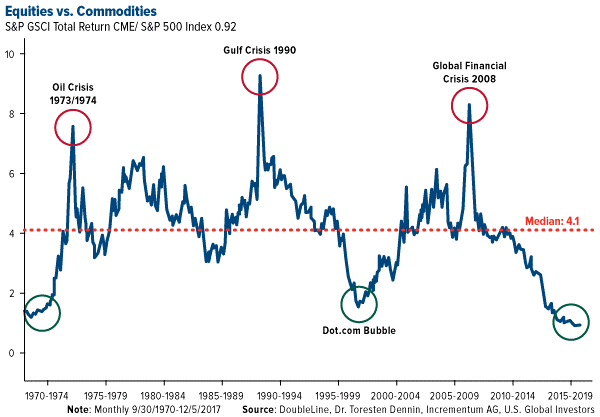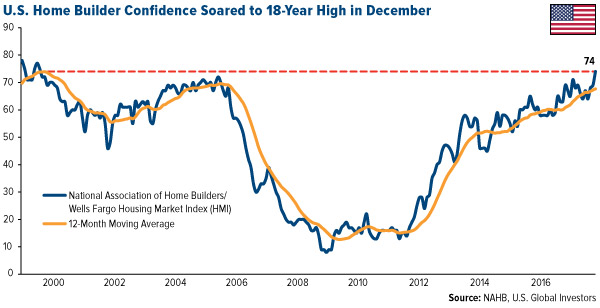Conditions are ripe for another housing boom. Economic growth is on the upswing. We’re at near-full employment. Inflation and mortgage rates are historically low. Housing as a whole adds between 15 and 18 percent to GDP, writes Frank Holmes, CEO of U.S. Global Investors.
In its November report, mortgage security firm Freddie Mac called 2017 the “best year in a decade” for the housing market by a variety of measures. These include low inflation, strong job growth and historically-low mortgage rates. This assessment is very encouraging, not just for homebuyers and builders and the U.S. economy in general, but also for commodities, resources and raw materials as we head into 2018.
Although past performance is no guarantee of future results, it’s still instructive to look back at how materials performed the last time the U.S. was ramping up housing starts and mortgages.
The last housing boom, which peaked in 2006, was accompanied by elevated commodity prices. We could see a return to these valuations over the next couple of years on higher demand, a stronger macroeconomic backdrop and cyclical fundamentals, as shown in the following chart courtesy of DoubleLine Capital:

Speaking on CNBC’s “Halftime Report” recently, DoubleLine founder Jeffrey Gundlach said he thought “investors should add commodities to their portfolios” for 2018, pointing out that they are just as cheap relative to stocks as they were at historical turning points.
“We’re at that level where in the past you would have wanted commodities” in your portfolio, Gundlach said. “The repetition of this is almost eerie. And so if you look at that chart, the value in commodities is, historically, exactly where you want it to be a buy.”
A wealth of positive housing data
There’s more to support the commodities narrative than cyclicality.
For one, home builders right now are more confident of the future than they’ve been in over 18 years. December’s National Association of Home Builders (NAHB)/Wells Fargo Housing Market Index (HMI) soared to 74, eight points up from the November reading and its highest report since July 1999.

NAHB Chairman Granger MacDonald chalks up the incredible improvement in optimism to “new policies aimed at providing regulatory relief to the business community.” Other contributing factors include low unemployment rates, favorable demographics and a tight supply of existing home inventory.
In addition, new housing starts in November rose to a seasonally adjusted annual rate of 1.3 million, up 3.3 percent from October and a strong 12.9 percent from a year ago.
This is all very constructive (no pun intended), as the market is still trying to recover nearly a decade following the subprime mortgage crisis.
Time to add commodities?
Indeed, all of the conditions appear ripe for another housing boom. Economic growth is on the upswing. The country is at near-full employment. Inflation and 30-year mortgage rates are also historically low.
When we factor in residential fixed investment and housing services, housing as a whole contributes between 15 and 18 percent to national gross domestic product (GDP). That’s a huge slice of the pie. And as I’ve pointed out before, housing has an extremely high multiplier effect. For every home that’s built, 2.97 full-time jobs and $162,080 in wages and salaries are created, according to a 2014 estimate by the NAHB.
Beyond that, increased home demand is good news for resources and raw materials. According to home-construction services firm Happho, for every 1,000 square feet of new housing, nearly 8,820 pounds of steel are required, as well as 400 bags of cement, 1,800 cubic feet of sand and 1,350 cubic feet of gravel and other aggregate. This doesn’t begin to touch on finishers such as brick, paint and tiles, or fittings such as windows, doors, plumbing and electrical.





















